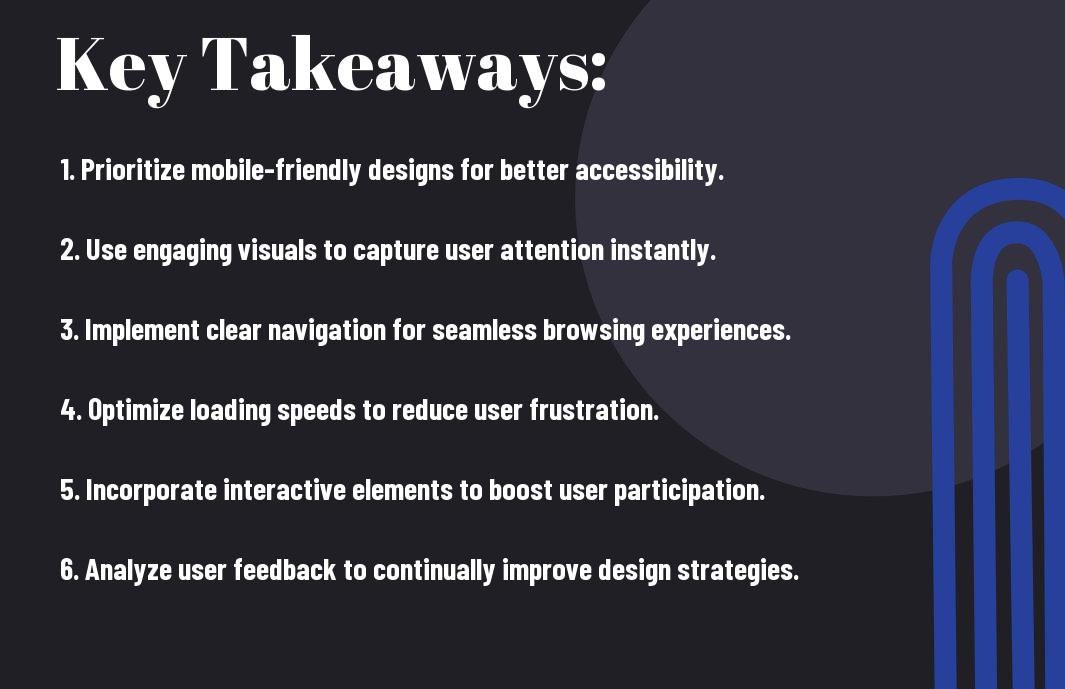There’s a significant opportunity for you to transform your small business by optimizing your website design. By focusing on user experience, you can create a more engaging and interactive platform that caters to your audience’s needs. Effective website design not only enhances usability but also drives customer engagement, fostering loyalty and increasing conversions. In this post, you’ll learn how innovative design elements can set your business apart, helping you connect more deeply with your customers and encouraging them to take action.
Key Takeaways:
- Prioritize mobile responsiveness to ensure a seamless experience for users on all devices, enhancing accessibility and convenience.
- Implement intuitive navigation and clear calls-to-action to guide visitors effortlessly through the site, fostering engagement and reducing bounce rates.
- Utilize engaging visuals and personalized content to captivate users, creating a stronger connection with the brand and encouraging repeat visits.

The Importance of User Experience in Small Business Websites
A well-designed website is vital for small businesses, as it serves as the digital storefront and often the first impression for potential customers. Prioritizing user experience (UX) ensures that visitors can navigate your site effortlessly, find information quickly, and feel engaged with your brand. A seamless UX not only fosters customer loyalty but also encourages word-of-mouth referrals, ultimately driving business growth.
Defining User Experience
Along with aesthetics, user experience encompasses the overall interaction users have with your website. This includes aspects such as usability, accessibility, and responsiveness. By delivering a positive experience, you enhance customer satisfaction, which can lead to increased conversions and retention.
The Impact of User Experience on Business Success
Any organization, especially small businesses, can feel the ripple effects of user experience on their success. When your website provides a seamless and engaging experience, customers are more likely to trust your brand and complete purchases. Investing in UX can lead to higher conversion rates and increased customer loyalty, which directly translates to improved revenue streams.
Small businesses must recognize that an effective user experience is not just a design choice, but rather a strategy that impacts your bottom line. A website that is easy to navigate and provides value builds trust with your audience and fosters a sense of connection. In today’s digital landscape, a negative experience can lead potential customers to quickly abandon your site, often opting for a competitor instead. By prioritizing UX, you are taking a significant step towards amplifying your brand’s visibility and enhancing customer satisfaction.
Key Elements of Innovative Website Design
There’s no doubt that innovative website design significantly enhances user experience and engagement. By focusing on key elements such as responsive design, visual aesthetics, and intuitive navigation, you can create a platform that not only captivates visitors but also encourages them to interact with your brand. Leveraging these elements effectively allows you to stand out in a crowded digital landscape.
Responsive Design
Beside ensuring that your website is accessible on all devices, responsive design plays a vital role in maintaining a seamless user experience. With today’s diverse range of screen sizes and resolutions, a responsive design allows your site to adapt fluidly, providing users with an optimal viewing experience anywhere, anytime.
Visual Aesthetics and Branding
One of the most impactful aspects of your website is its visual aesthetics and branding. This includes color schemes, typography, and imagery that resonate with your target audience and reflect your brand identity.
In addition, effective visual aesthetics can enhance user perception and increase trust in your brand. By using cohesive color palettes, engaging images, and distinctive typography, you create a memorable impression that aligns with your values. Prioritizing these elements helps you convey professionalism and fosters a sense of connection with your audience. A well-branded website not only draws users in but also encourages them to explore further, ultimately driving greater engagement and loyalty to your business.
Enhancing Engagement through User-Centric Features
Your website’s design should prioritize user-centric features, fostering a positive experience that keeps visitors engaged. By focusing on the needs and preferences of your users, you can create an interactive environment that encourages exploration and interaction, ultimately driving higher engagement levels and repeat visits. Incorporating elements that appeal to your audience’s interests and behaviors not only enhances usability but also establishes a connection between your brand and your customers.
Interactive Content
On your website, integrating interactive content such as quizzes, polls, and user-generated galleries can significantly boost user engagement. These features invite visitors to participate actively rather than passively consume information. This interactivity creates a dynamic atmosphere that captivates your audience and enhances their experience, leading to longer visits and a deeper connection to your brand.
Personalization Techniques
Any attempt to enhance user engagement through personalization techniques should revolve around tailoring experiences to individual visitors. By utilizing data analytics and user feedback, you can customize content, product recommendations, and navigation paths to align with the specific preferences of your audience, fostering a sense of belonging and satisfaction.
Even small businesses can benefit greatly from implementing personalization techniques to enhance user experience. By adjusting content based on user behavior and preferences, you not only create a more tailored environment but also build strong customer loyalty. Personalized recommendations can lead to increased conversions, while a customized experience encourages users to spend more time on your site. However, it is crucial to maintain a balance between personalization and privacy concerns. Always ensure users feel secure, as trust is key when navigating personal data usage.
Leveraging Technology for Improved User Experience
Keep in mind that integrating advanced technologies can significantly enhance your website’s user experience. By utilizing modern tools and techniques, you can create a more engaging and intuitive interface that keeps visitors coming back. Emphasizing technology not only streamlines navigation but also offers valuable insights into user behavior, helping you optimize your site further.
AI and Chatbots
One of the most effective ways to boost engagement on your website is through the use of AI and chatbots. These tools can provide real-time support, answering customer queries instantly and enhancing user satisfaction. By implementing chatbots, you can ensure that your visitors receive immediate assistance, improving overall engagement and conversion rates.
Fast Load Times and Website Performance
Website performance plays a vital role in user experience. Fast load times can lead to better engagement, while slow websites can drive users away. You should prioritize performance optimization to keep visitors interested and reduce bounce rates.
Improved load times positively impact your website’s performance and user satisfaction. By optimizing images, reducing server response times, and leveraging caching, you can ensure that your site loads quickly. A fast website not only enhances the user experience but also boosts your site’s search engine rankings, making it easier for potential customers to find you. Speed is important in retaining visitors; the longer someone has to wait, the greater the chance they will leave your site in search of faster alternatives.
Analyzing User Behavior for Continuous Improvement
After launching your website, it’s imperative to regularly analyze user behavior. This analysis will inform you about how visitors interact with your site, highlighting areas that may require enhancement. By understanding these patterns, you can continuously improve your website design, making it more intuitive and engaging, ultimately driving higher user satisfaction and retention rates.
Utilizing Analytics Tools
With the right analytics tools at your disposal, you can track and measure user interactions on your website effectively. These tools will provide insights into metrics such as page views, session duration, and bounce rates, allowing you to identify which content resonates with your audience and which areas may need adjustment for optimal engagement.
User Feedback and Testing
Any input from your users is vital for enhancing their experience. Engaging with your audience through surveys, comments, and usability testing allows you to gather imperative feedback that pinpoints both strengths and weaknesses. This direct communication helps you make informed adjustments to your website, ensuring that your design aligns with user preferences and expectations.
Analyzing user feedback facilitates a deep understanding of your audience’s needs and desires. By implementing structured testing, such as A/B tests or focus groups, you can discover what elements of your design are well-received and which might cause frustration. Such insights enable you to make informed modifications that enhance usability and promote a better overall experience. This practice not only bolsters user satisfaction but also fosters lasting engagement with your brand.
Best Practices for Small Business Website Design
Not all website designs are created equal; implementing best practices can elevate your small business online. Prioritize a clean layout that enhances navigation and ensures mobile-friendliness. Use high-quality images and concise content to keep your visitors engaged, while clear calls-to-action guide them through your site. Your goal should be to create an inviting, user-friendly experience that encourages potential customers to explore more.
Keeping Content Fresh and Relevant
Along with design, regularly updating your content is vital for retaining visitor interest. By incorporating current trends or addressing common customer queries, you not only keep your audience informed but also improve your site’s SEO. Regular updates can encourage repeat visits and foster a sense of community around your brand.
Integrating Social Media and Community Engagement
An effective website design goes hand-in-hand with social media and community connection. By integrating social media platforms directly into your website, you extend engagement opportunities for your visitors. Ensuring that your website features links to your social media profiles allows users to follow your business easily, while sharing capabilities can amplify your reach.
Further, actively engaging with your audience through social media fosters a sense of community. Encourage your website visitors to share their experiences and feedback on social platforms, thereby creating a two-way interaction. Utilize user-generated content and reviews to build credibility and trust with potential customers. This comprehensive approach not only boosts engagement on your site but also strengthens your brand’s online presence, leading to increased conversions and loyal customers.
Final Words
On the whole, effective website design for small businesses can significantly enhance user experience and foster engagement. By prioritizing intuitive navigation, responsive layouts, and visually appealing elements, you can keep your visitors captivated and encourage them to interact with your content. Implementing personalized features and optimizing for mobile use allows for deeper connections with your audience. Additionally, leveraging analytics helps you understand user behavior, enabling continual improvements. By focusing on these aspects, you can create a compelling online presence that drives growth and builds lasting relationships with your customers.
Q: How does website design impact user experience for small businesses?
A: Website design plays a significant role in shaping user experience for small businesses. A well-designed site can enhance navigation, making it easier for users to find the information they need. Clear layouts and intuitive interfaces contribute to a more enjoyable browsing experience. Incorporating responsive design ensures that the website functions well on various devices, accommodating visitors who use mobile phones or tablets. Moreover, visually appealing elements such as colors, fonts, and images can draw in users, making them more likely to stay on the site longer and engage with content.
Q: What innovative features can small businesses incorporate to increase user engagement on their websites?
A: Small businesses can adopt several innovative features to boost user engagement on their websites. For instance, interactive elements such as polls, quizzes, or calculators can encourage visitors to participate actively. Adding live chat support allows users to ask questions in real-time, creating a more personalized experience. Integrating social media feeds can keep the website dynamic and encourage visitors to follow the business on different platforms. Additionally, utilizing video content to showcase products or services can engage users more effectively than static images or text, capturing their attention and enhancing understanding.
Q: How can small businesses measure the effectiveness of their website design in enhancing user experience?
A: Small businesses can evaluate the effectiveness of their website design through several metrics and tools. Analytics platforms such as Google Analytics provide insights into user behavior, including page views, bounce rates, and the average time spent on the site. Heatmaps can visually represent user interactions, showing where visitors click and scroll, providing valuable feedback on design elements that work well or need improvement. Additionally, conducting user surveys or feedback forms can offer direct insights into user satisfaction and preferences. By analyzing this data, businesses can make informed design choices that enhance the overall user experience and drive engagement.



